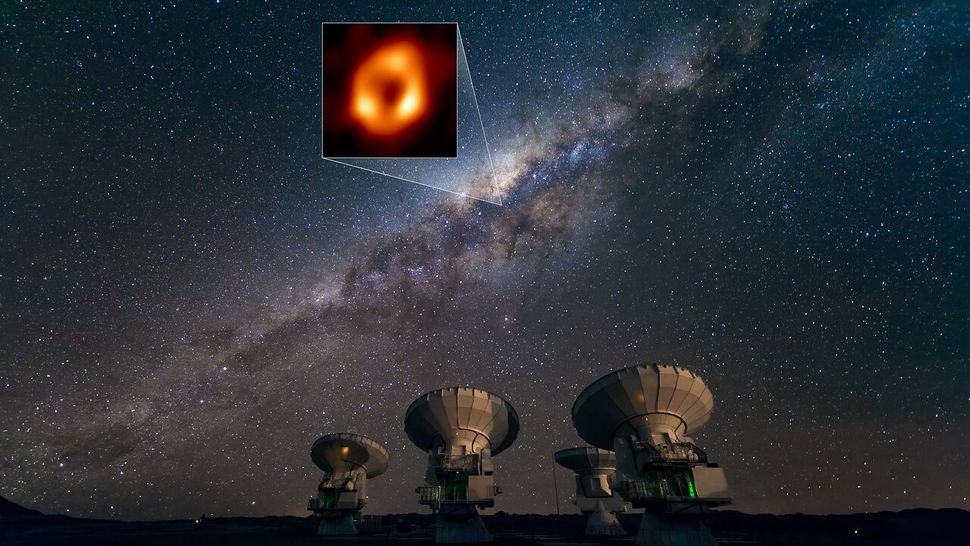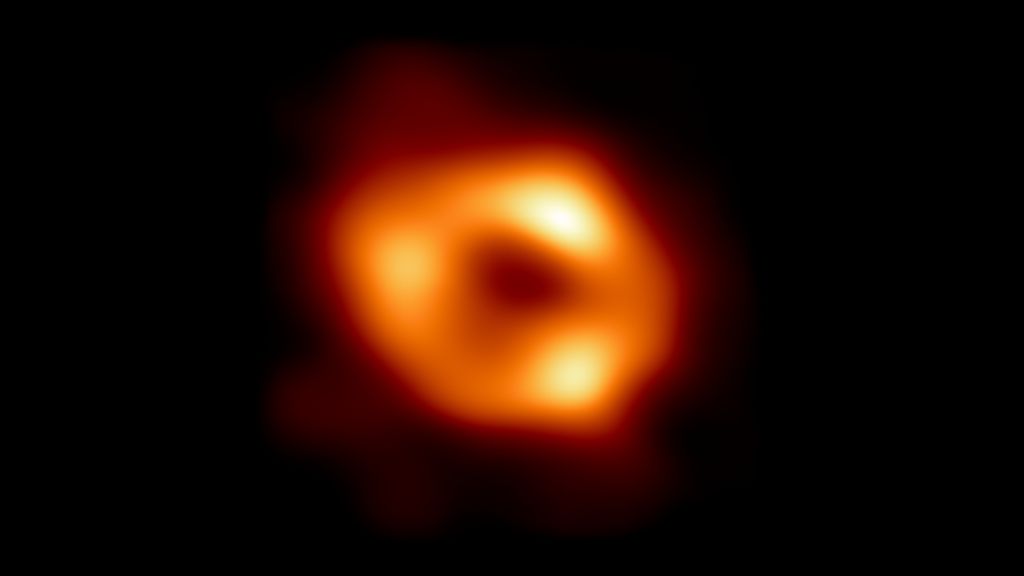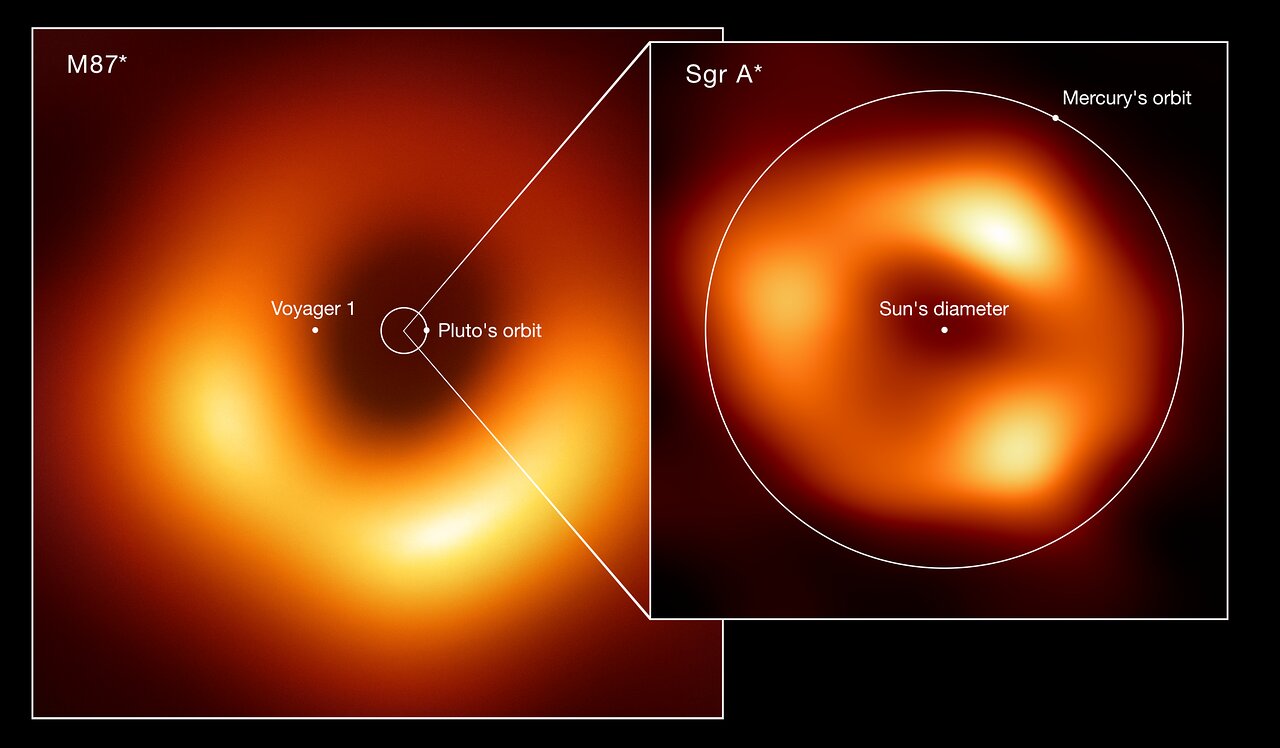Science
Related: About this forum1st image of our galaxy's 'black hole heart' unveiled
By Ben Turner published 4 minutes ago
The giant black hole is at the heart of the Milky Way

The Milky Way and the location of its central black hole as viewed from the Atacama Large Millimeter/submillimeter Array. (Image credit: ESO/José Francisco Salgado (josefrancisco.org), EHT Collaboration)
Astronomers have captured the first ever image of the colossal black hole at the center of our galaxy, providing the first direct evidence of the cosmic giant's existence.
Located 26,000 light-years away, Sagittarius A* is a gargantuan tear in space-time that is four million times the mass of our sun and 40 million miles (60 million kilometers) across. The image was captured by the Event Horizon telescope (EHT), a network of eight synchronized radio telescopes placed in various locations around the world.
As not even light is able to escape the powerful gravitational pull of a black hole, it's impossible to see Sagittarius A* itself except as the silhouette of a ring of fuzzy, warped light. This halo comes from the superheated, glowing matter swirling around the entrance to the cosmic monster's maw at close to the speed of light. Once the slowly stripped and shredded plasma plunges over the black hole's precipice, or event horizon, it is lost inside forever.
"Our results are the strongest evidence to date that a black hole resides at the centre of our galaxy," Ziri Younsi, an astrophysicist at University College London and an EHT collaborator, said in a statement. "This black hole is the glue that holds the galaxy together. It is key to our understanding of how the Milky Way formed and will evolve in the future."
More:
https://www.livescience.com/first-image-black-hole-center-of-milky-way?utm_source=notification
Judi Lynn
(160,516 posts)By Elizabeth Howell published about 1 hour ago
"What's more cool than seeing the black hole in the center of our own Milky Way?"

An image of the supermassive black hole at the center of the Milky Way, a behemoth dubbed Sagittarius A*, revealed by the Event Horizon Telescope on May 12, 2022. (Image credit: Event Horizon Telescope collaboration)
For decades, astronomers have wondered what's at the heart of the Milky Way galaxy. Today, scientists unveiled the first-ever photo of the supermassive black hole that lurks there, offering a completely new view of our home galaxy.
The historic image of what scientists call Sagittarius A*, captured by a worldwide telescope array called the Event Horizon Telescope (EHT) and released Thursday (May 12), confirms a black hole in the heart of the Milky Way feeding on a hydrogen gas. EHT is most famous for capturing the first-ever black hole image of M87's supermassive black hole in 2019, but for scientists on the project, today's image is a still more remarkable milestone.
"I wish I could tell you that second time is as good as the first one imaging black holes. But that wouldn't be true. It is actually better," Feryal Özel, EHT modeling lead and a professor of astronomy and astrophysics at the University of Arizona, said during a press conference Thursday.
Özel has been examining Sgr A*, as the black hole is nicknamed, for 22 years since her graduate student days. Imaging a second black hole with EHT shows the telescope's capabilities "wasn't a coincidence," Özel added, saying, "We now know that in both cases, what we see is the heart of the black hole — the point of no return."
More:
https://www.space.com/milky-way-black-hole-1st-photo-scientists-excited
Judi Lynn
(160,516 posts)By Tereza Pultarova published about 4 hours ago
"The theory of general relativity says that black holes only have two qualities: mass and spin," Nobel Prize winner Reinhard Genzel explains.

Reinhard Genzel won the 2020 Nobel Prize in Physics for his research into the black hole at the center of our galaxy, the Milky Way. (Image credit: Max Planck Institute for Terrestrial Physics)
Nobel Prize-winning physicist Reinhard Genzel talks to Space.com about the questions scientists want answered about the supermassive black hole at the center of our galaxy. Spoiler alert: Those answers may be coming soon.
There are few people in the world as qualified to talk about the black hole at the center of our galaxy as 2020 Nobel Prize in Physics laureate Reinhard Genzel. It was his decades-long research into this odd object called Sagittarius A* that gathered enough evidence to prove "beyond any reasonable doubt" that this radio wave-emitting body is indeed the Milky Way's central supermassive black hole.
And any residual doubt has now been removed by a different team, the Event Horizon Telescope partnership. The EHT team made waves in 2019 by taking the first-ever photograph of a black hole, the supermassive one at the heart of the distant galaxy M87 — and has now done the same with Sagittarius A*.
The journey to determine the mass
Genzel, who is the director of the Max Planck Institute for Extraterrestrial Physics in Germany, and his team use the Very Large Telescope in Chile to observe stars orbiting very close (a few times the distance of the dwarf planet Pluto from the sun) to Sagittarius A*. Through decades of observations, they were able to analyze orbits of these stars as they hurtle around the galactic center at mind-boggling speeds of thousands of miles per second (up to 40 times faster than the orbital speed of the sun).
More:
https://www.space.com/milky-way-black-hole-mysteries-reinhard-genzel-interview
Warpy
(111,245 posts)because it contains illustrations of the comparative sizes of SgrA+ and M 87, the first one they imaged. Sgr A+ is a relative pipsqueak compared to the first one imaged, so this result is pretty astonishing.

https://www.sciencealert.com/live-scientists-reveal-groundbreaking-results-from-event-horizon-telescope